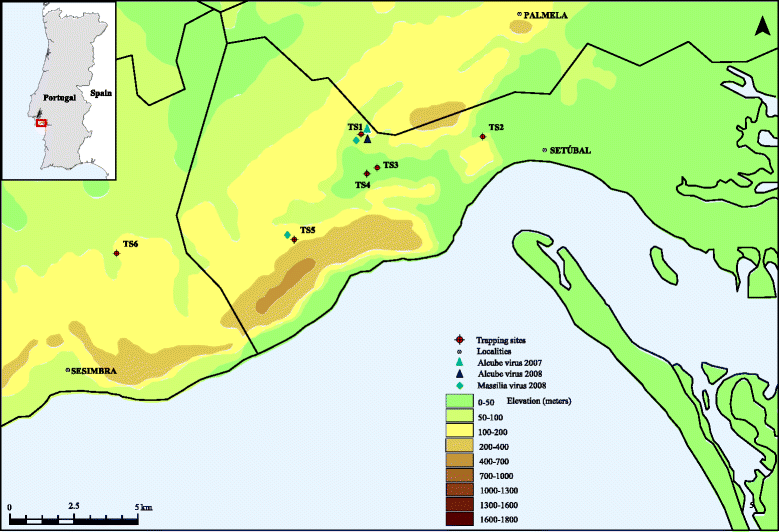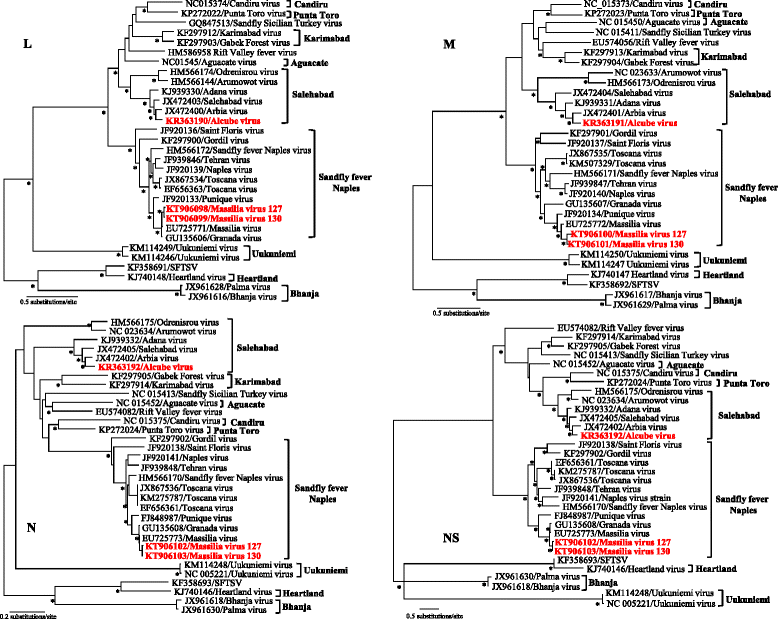Co-circulation of a novel phlebovirus and Massilia virus in sandflies, Portugal
- PMID: 26497645
- PMCID: PMC4619550
- DOI: 10.1186/s12985-015-0407-0
Co-circulation of a novel phlebovirus and Massilia virus in sandflies, Portugal
Abstract
Background: In Portugal, entomological surveys to detect phleboviruses in their natural vectors have not been performed so far. Thus, the aims of the present study were to detect, isolate and characterize phleboviruses in sandfly populations of Portugal.
Findings: From May to October 2007-2008, 896 female sandflies were trapped in Arrábida region, located on the southwest coast of Portugal. Phlebovirus RNA was detected by using a pan-phlebovirus RT-PCR in 4 out of 34 Phlebotomus perniciosus pools. Direct sequencing of the amplicons showed that 2 samples exhibited 72 % nucleotide identity with Arbia virus, and two showed 96 % nucleotide identity with Massilia virus. The Arbia-like virus (named Alcube virus) was isolated in cell culture and complete genomic sequences of one Alcube and two Massila viruses were determined using next-generation sequencing technology. Phylogenetic analysis demonstrated that Alcube virus clustered with members of the Salehabad virus species complex. Within this clade, Alcube virus forms a monophyletic lineage with the Arbia, Salehabad and Adana viruses sharing a common ancestor. Arbia virus has been identified as the most closely related virus with 20-28 % nucleotide and 10-27 % amino acid divergences depending on the analysed segment.
Conclusions: We have provided genetic evidence for the circulation of a novel phlebovirus species named Alcube virus in Ph. perniciosus and co-circulation of Massilia virus, in Arrábida region, southwest of Portugal. Further epidemiological investigations and surveillance for sandfly-borne phleboviruses in Portugal are needed to elucidate their medical importance.
Figures


References
-
- Peters CJ, Makino S, Morrill JC. Rift Valley Fever. In: Guerrant RL, Walker DH, Weller PF, editors. Tropical Infectious Diseases Principals, Pathogens and Practice. 3. Philadelphia: Suanders Elsevier; 2011. pp. 462–465.
-
- Palacios G, Tesh R, Travassos Da Rosa A, Savji N, Sze W, Jain K, et al. Characterization of the Candiru antigenic complex (Bunyaviridae: Phlebovirus), a highly diverse and reassorting group of viruses affecting humans in tropical America. J Virol. 2011;85:3811–3820. doi: 10.1128/JVI.02275-10. - DOI - PMC - PubMed
Publication types
MeSH terms
Substances
Associated data
- Actions
- Actions
- Actions
- Actions
- Actions
- Actions
- Actions
- Actions
- Actions
LinkOut - more resources
Full Text Sources
Other Literature Sources
Molecular Biology Databases

